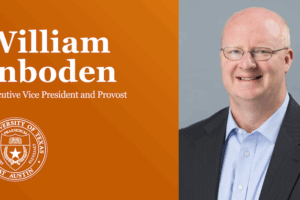Matthew Robinson leaned in close so I could better hear him over the raucous, stream-of-consciousness harmonica solo being played by Mike Milligan, the charismatic front man for local Austin workhorses the Altar Boyz. Although modest when discussing his own considerable talent, Robinson is not one to rein in the praise when he hears some good blues. After a hearty deep-bellied laugh, infectious although barely audible over Milligan’s amplified harp, Robinson exclaimed: “Oh, man! He’s really puttin’ some juice in that thing now!”
Blues music and integration have been long intertwined in Austin, according to Roger Gatchet, a doctoral student and blues enthusiast who is hooked on oral history. Gatchet interviewed east Austin musicians Matthew Robinson, Donald “Duck” Jennings and Henry “Bluesboy” Hubbard as part of an oral history project. Robinson, Jennings and Hubbard played in east Austin in the 1950s and 1960s, an era Gatchet has described as “one of the liveliest blues scenes in the Lone Star state.”
Gatchet’s work was part of the Interpreting Texas Past (ITP): African Americans Oral History Project, conducted under the Intellectual Entrepreneurship consortium, which is part of the Division of Diversity and Community Engagement, and was featured in Living Blues magazine.
ITP was an oral history project started a decade ago by Dr. Martha Norkunas, a public historian and a lecturer in the Anthropology Department. Spurred by the 40th anniversary of the Civil Rights Act in 2004, Norkunas began to concentrate on capturing the stories of African Americans. Norkunas and the students enrolled in her oral history seminars have collected 110 oral histories — 58 of those from east Austinites.
“The role of east Austin in shaping the City of Austin as we now know it is immense — the Austin music scene is a perfect example,” said Dr. Gregory Vincent, the university’s vice president for diversity and community engagement. “Preserving east Austin’s history continues to be important especially as plans for the African American Cultural Heritage District develop.”
The east Austin music scene thrived in large part because it was one of several communities in Texas that were part of the Chitlin’ Circuit. The circuit was a tour that included big-name African American musicians like B. B. King and Ike and Tina Turner. The tour began around Chicago and worked its way South, playing in venues where African Americans were able to listen to music.
Though big-name musicians played only in well-established east Austin clubs, many of the businesses frequented by east Austinites who loved music were informal spaces.
“So what a lot of them did was take their home, and little old box houses, it was kind of like a little living area and a bedroom, right here, and they’d knock this wall out, and block this right here, and they had a club,” Jennings told Gatchet. “They lived, put a room back here maybe, if the house was big enough they wouldn’t have to do nothing. Just move all that back here, and they had a club. And several houses did that.”
Other businesses were better known such as Charlie’s Playhouse, Ernie’s Chicken Shack and the Victory Grill. Hubbard and his band, “Bluesboy” Hubbard and the Jets, were regulars at Charlie’s Playhouse and the Chicken Shack, both owned by Charlie Earnest Gildon. Young Matthew Robinson would sneak into the clubs to listen to the music and sometimes jam with his father Matthew Robinson Sr.
“All it is is a conversation,” Robinson said. “That’s what music is, communicating a way of life. And it’s a lifetime thing if you love it. And if you don’t love it, it’s going to beat you down. [laughs] So, I realized that I was a bluesman, after many years of doing all kinds of things I finally realized it and I’m just going to accept my path and keep it going.”



